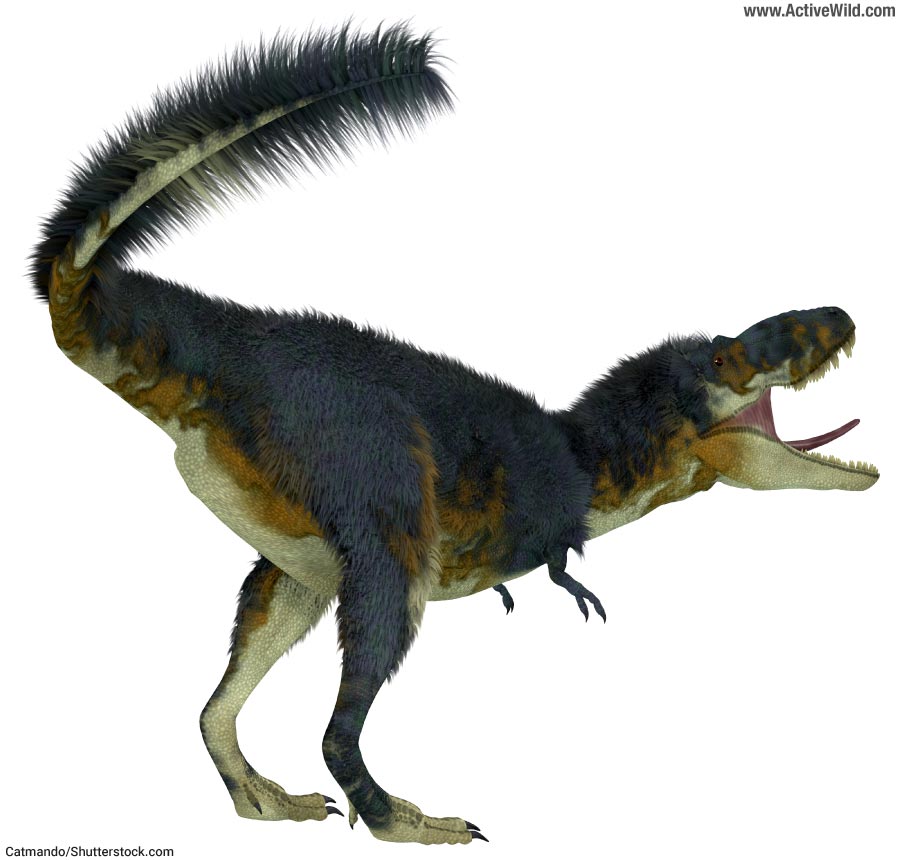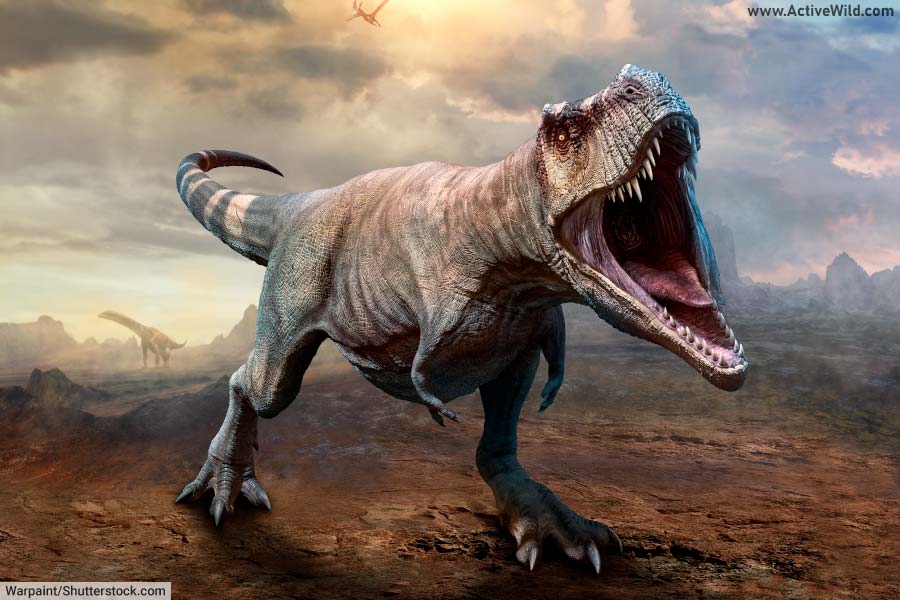The recent discovery of a new dinosaur species, Daspletosaurus wilsoni, has helped scientists fill in the gaps in the evolutionary history of tyrannosaurid dinosaurs, settling decades of debate amongst paleontologists.
How Was The New Dinosaur Discovered?
The fossilized remains of the new dinosaur were found in northeastern Montana, USA, between 2017 and 2021. Paleontologists from the Badlands Dinosaur Museum in North Dakota were excavating a large area at the Judith River Formation when the discovery was made. (source)
The dinosaur, which lived 76.5 million years ago during the Cretaceous Period, was named Daspletosaurus wilsoni after crew member John Wilson, who first made the discovery.
Wilson spotted a flat piece of bone sticking out of the bottom of a cliff. After careful digging, the fossil was found to be a complete premaxilla – the bone which forms the tip of the dinosaur’s snout.

Several broken vertebrae were also found around the site, indicating that this was a large tyrannosaur, but around 25 feet of rock stopped the researchers from reaching the rest of the bones. During 2020 and 2021, field crews then used a jackhammer to dig down and unearthed a partial skull and skeleton.
The team found the job of removing all this rock seemingly endless, and named the fossil find “Sisyphus”. (In Greek mythology, Sisyphus is a king forced to spend eternity pushing a rock up a hill as punishment for cheating death.)
- You can find out more about fossils on this page: Fossil Facts
What Type Of Dinosaur Is Daspletosaurus?
Daspletosaurus belonged to the Tyrannosauridae family, a group of large, predatory dinosaurs that lived between 79.5 and 74 million years ago, during the Late Cretaceous period. The best-known member of this family – and perhaps the most famous of all dinosaurs – is the fearsome Tyrannosaurus rex.
- You can find out more about T. rex on this page: T. rex Facts
- You can see other Cretaceous Period dinosaurs on this page: Cretaceous Period Dinosaurs
The tyrannosaurids lived in what is now western North America, but what was then Laramidia – an island continent separated from Appalachia, the eastern part of what is now North America, by a shallow sea known as the Western Interior Seaway.
Tyrannosaurid dinosaurs are characterized by their massive skulls, thick teeth, and very short front limbs. They were more closely related to birds than any other group of animals, and it’s thought that they probably preyed on other large dinosaurs.

Some specimens have indicated that tyrannosaurids had special sensory organs that could have been used for temperature reading and prey detection, like crocodiles today. (source)
There is evidence to suggest that Daspletosaurus lived in social groups. A site in Montana held the remains of a large adult, a juvenile, and a medium-sized individual. By looking at geological evidence, scientists have found that they were all buried at the same time and not brought together by river currents, so must have been together at the time of death.
To date, only three Daspletosaurus species have been found. The oldest is D. torosus from Alberta, D. horneri is the more recent species, and D. wilsoni which has now been found to sit between the two.
What Makes This Discovery Important?
While studying the fossils of Daspletosaurus wilsoni, paleontologists found that it displayed a variety of features that are found in more primitive tyrannosaurs from older rocks, including horns around the eyes. But they also had features from later members of the family, such as expanded air pockets in the skull and tall eye sockets.
This has shown that the species is a halfway point, or “missing link”, between the older and younger species of tyrannosaur. These findings also support previous research which suggested that several Daspletosaurus species were part of a single lineage, all evolving from one common ancestor.
Settling A Thirty-Year Debate
Since the 1990s, scientists have been unable to say where Daspletosaurus fits into the evolution of tyrannosaurs. It had been proposed that they were ancestors of Tyrannosaurus rex but there were no good Daspletosaurus specimens to support this.
Many paleontologists have disagreed as to whether these dinosaurs represent one single lineage or multiple related species from different lineages. But these new findings show that these species were from a single lineage, each forming a step on the evolutionary ladder, with one species evolving directly into its descendant.
What Does This Tell Us About Dinosaur Evolution?
In North America during the Late Cretaceous period, many dinosaur families were represented by several closely-related species. It was previously thought that these species represented a diverse group of animals living at the same time. However, this new discovery, alongside several others has given us a better understanding of how these species were placed over time.
We can now be sure that many of these dinosaurs evolved into each other and were only finely separated in time, a mode of evolution known as anagenesis. (By contrast, cladogenesis is the evolutionary process in which branching events produce closely-related species that look very similar but are actually evolutionary cousins, rather than direct descendants.)
How Does This Link To Tyrannosaurus rex?
These new findings allow tyrannosaurs to be added to a growing list of dinosaur species, including horned and duckbilled dinosaurs, for which anagenesis has been proposed. This suggests that this mode of linear evolution is more common amongst dinosaurs than previously thought and also supports the theory that Tyrannosaurus rex evolved from Daspletosaurus.
T. rex existed around 10 million years after Daspletosaurus, and during that time had evolved to become a far larger and more powerful predator than its ancestors.
Daspletosaurus reached around 30 feet in length and weighed up to 3 tons, while T. rex reached a length of up to 40 feet and weighed an incredible 10 tons.
Although there were other dinosaurs that exceeded this size, T. rex is still amongst the largest-known land predators in the history of our planet. It’s thought that this fearsome prehistoric predator had the strongest bite force of all terrestrial animals and the largest teeth of any carnivorous dinosaur. The longest T. rex tooth is 12 inches long.
Humble Beginnings
Although T. rex was one of the largest terrestrial predators and is today the most widely recognized dinosaur species, it actually evolved from dinosaurs no larger than a small child.
Suskityrannus hazelae lived 92 million years ago and weighed between 45 to 90 pounds (20 to 40 kilograms). It only reached 3 feet in height and measured around the same length as the T. rex’s skull. Although their lineages split in the early Cretaceous period, this small species pre-dates large tyrannosaurs by only 10 million years – a relatively narrow window of time for such a large increase in size.
Why Did Tyrannosaurs Become So Large?
Tyrannosaurs evolved their large size relatively quickly on the geological time scale and paleontologists aren’t sure exactly why.
There is a significant lack of fossil records from the Mid-Cretaceous period when these dinosaurs began to get larger. Between 94 and 90 million years ago, sea levels were at their highest, eroding sediments that would usually preserve the remains of these creatures. Only a few sites in North America have successfully preserved dinosaurs from this period.
Each new fossil discovery linked to tyrannosaurs provides a rare insight into the evolutionary steps that led to their sudden growth. More detailed research is now being done to investigate the link between Daspletosaurus and T. rex, as any further information on their evolution may help to explain when and why the later tyrannosaurids – including T. rex – became so large.
Discover More With Active Wild
- You can find out more about Tyrannosaurus Rex on this page: Tyrannosaurus Rex Facts
- Discover more dinosaurs of the Cretaceous Period here: Cretaceous Period Dinosaurs
- See what animals lived alongside dinosaurs during the Cretaceous Period: Cretaceous Period Animals (That Weren't Dinosaurs)
- Become a dinosaur expert: Dinosaurs - The Ultimate Guide

